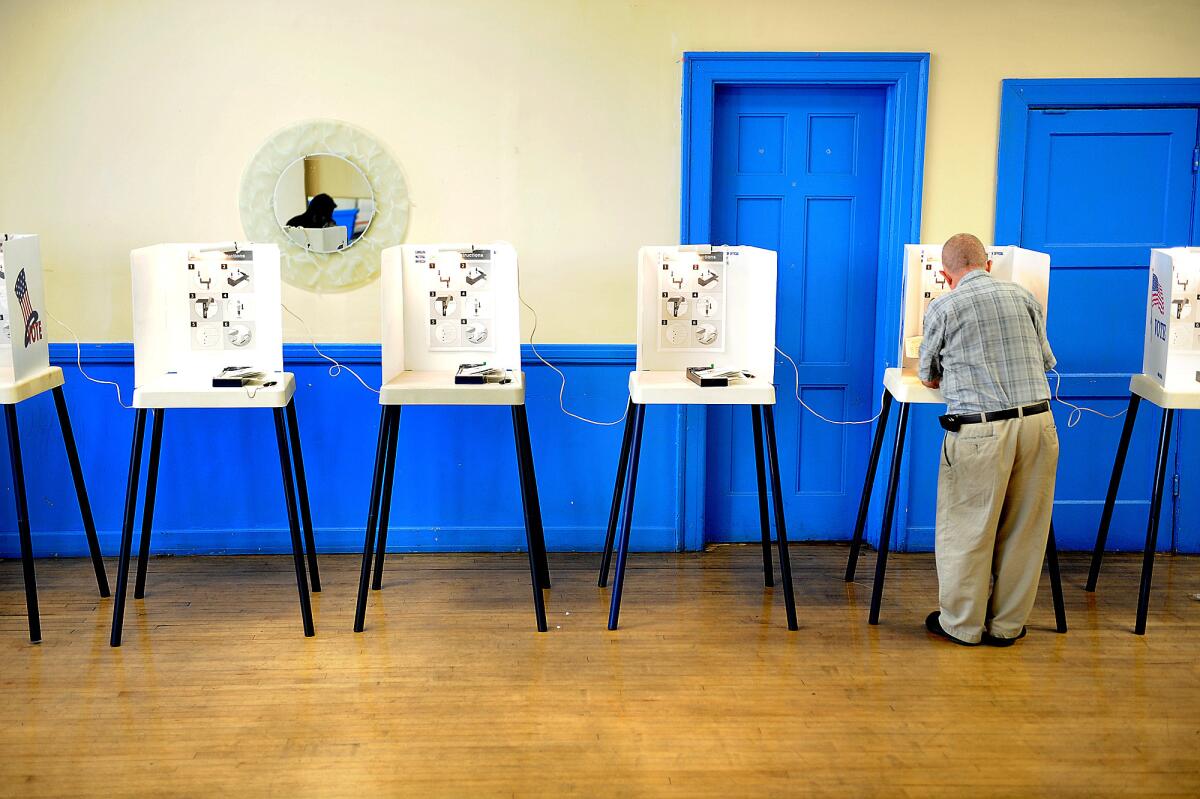Donald Trump claims the election might be ‘rigged.’ Here’s how voting really works

- Share via
Of all the controversies that have cropped up during Donald Trump’s presidential campaign, his assertion that the general election could be “rigged” inspired one of the swiftest rebuttals.
A fundamental part of any election is widespread acceptance of the validity of the results, and if Trump were to lose and claim fraud without evidence, political scientists and others argued, he would undermine the electoral process.
Trump, increasingly losing ground in polls, told supporters at a rally this month that he’s afraid the election results won’t reflect voters’ intent. He threw his support behind voter ID rules while campaigning in Wilmington, N.C., this week, saying they help protect against fraud. But an appeals court ruled last month that the state’s voter ID law was enacted “with discriminatory intent” against black voters.
Some state legislatures have promoted voter ID laws as a way to prevent election fraud, while critics contend that the regulations target and disenfranchise minority voters, who tend to vote for Democrats.
Some of Trump’s supporters share his concern. According to a poll released by Public Policy Polling this week, 69% of Trump backers in North Carolina think a Hillary Clinton win would be the result of a rigged election.
But an examination of how votes are cast and tallied in the U.S. shows that it would be extremely difficult for anyone to commit voter fraud at a scale that would tip an election or for election officials to rig balloting. This is how the voting process works:
Who counts the votes and how?
There is no national system or code that dictates how election votes should be tabulated.
The Election Assistance Commission, a government board established after the close 2000 presidential election that went to the Supreme Court, notes that “votes are aggregated and counted by local election officials as prescribed by state law” in the country’s roughly 13,000 election jurisdictions.

State election officials are responsible for certifying election results for races that cross jurisdictions, such as gubernatorial and senatorial races. State authorities also must certify election results for the presidency and vice presidency.
The federal government’s involvement comes when votes for president and vice president are certified by Congress. The losing candidate in a contested U.S. House or Senate race can appeal to Congress as well.
The process helps minimize errors and instances of fraud, the commission says.
“Decentralization limits the opportunities for fraud or corruption, by making it extremely difficult to accomplish on a scale grand enough to be decisive without being detected,” according to the commission.
What about voter fraud?
Investigations into voter fraud show it is “extraordinarily rare,” according to a report from the Brennan Center for Justice, which noted, “There are surprisingly few sources recounting specific incidents of alleged voter fraud.”
An investigation into reports of voter fraud after Indiana passed a voter ID law in 2005 showed only nine cases out of 250 in which someone voted using another person’s name, said Justin Levitt, an election law expert who conducted the investigation and was interviewed by the Associated Press.
“They identified a lot of fraud, but very, very, very, very, very, very little of it could be prevented by identification at the polls,” he said.
The instances of fraud identified — including ballot-stuffing or vote buying — would not have been prevented by voter ID, according to Levitt.
Voter fraud is an issue that tends to fall along party lines. According to the National Conference of State Legislatures, 34 states have laws requesting or requiring voters to show a form of ID before they vote. Some states with strict photo ID laws, including Wisconsin, Indiana, Kansas and Texas, have Republican governors or Republican majorities in their statehouses, or both.
Court decisions have varied regarding the effect of these laws. In his decision last month declaring parts of Wisconsin’s voter ID law unconstitutional, U.S. District Judge James Peterson wrote, “To put it bluntly, Wisconsin’s strict version of voter ID law is a cure worse than the disease.”
However, the 7th District Court of Appeals issued a stay on another ruling that would have allowed Wisconsin residents without photo IDs to vote by signing an affidavit saying they could not obtain identification.
Follow me: @Jill_Ornitz
Paul Manafort has guided dictators and strongmen, but can he manage Donald Trump?
As Hillary Clinton goes after Donald Trump, her own email troubles undermine her attacks
Reality check: Manufacturers returning to U.S. may mean jobs for robots, not people
Get the L.A. Times Politics newsletter
Deeply reported insights into legislation, politics and policy from Sacramento, Washington and beyond. In your inbox twice per week.
You may occasionally receive promotional content from the Los Angeles Times.







